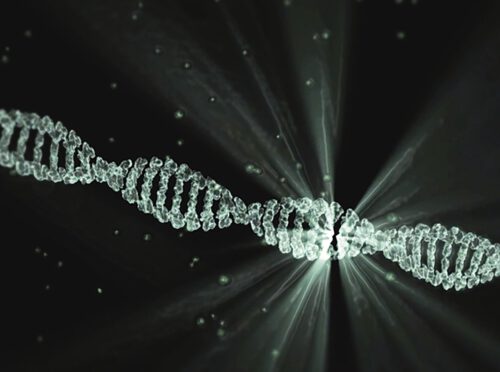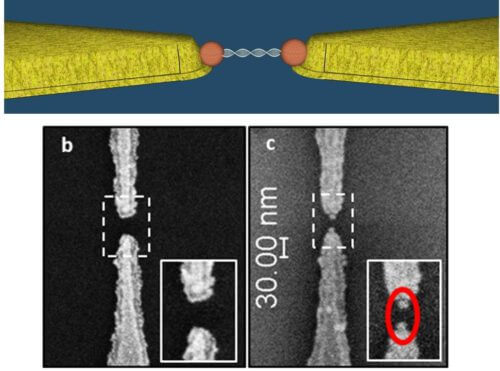A study published in Nature Nanotechnology led by Prof. Dani Porat of the Hebrew University demonstrated for the first time the conduction of a significant electric current over a long distance in DNA molecules. The researchers were surprised to discover that the electrical conduction goes through the DNA pathway, which was considered an unlikely conduction channel. The discovery is currently used as a basis for the development of a detector that can sensitively and quickly detect cancer markers and even the corona virus

Technological development in recent decades has increased the need to manufacture chips and tiny electronic components to create powerful computing power in less storage volume. Until now, the same miniaturization has been achieved with traditional technological tools in the computing world, but continuing the same miniaturization trend requires thinking outside the box. New directions led the researchers to turn back to "Mother Nature", who, it turns out, also teaches us a thing or two in the nanometer world, such as the aspiration to use DNA to develop electrical devices.
So far, the scientific community has established the hypothesis that an electric current can pass through the DNA molecules, but there has never been an unequivocal experiment in which a relatively high current was measured over a long distance in a single double-stranded DNA molecule, and which accurately explained the conduction mechanism. In the last twenty years, the accepted paradigm was that the electric current passes through the DNA bases that bind the two helices. However, the results regarding the conduction mechanism were not unequivocal and in some cases even contradicted the possibility that a current could pass through the DNA molecule.
In an article published a few days ago In the prestigious journal "Nature Nanotechnology", an international team of scientists led by researchers from the Hebrew University, led by Prof. Danny Porat from the Institute of Chemistry and the Center for Nanoscience and Nanotechnology, succeeded for the first time in measuring the conduction of a significant electric current in a single and relatively long double-stranded molecule of DNA, and explain the mechanism behind the conduction. The success of placing and identifying individual molecules between electrodes and measuring electrical currents in individual DNA molecules allowed the researchers to show that, contrary to the paradigm that has dominated for about 20 years, the majority of the current actually passes through the DNA pathway (the outer part of the double helix - a system of sugars and phosphates). The uniqueness of this method is the degree of reliability, the frequency of the experiment and the stability that allowed a wide variety of experiments to be performed, from which it is possible to learn about the conduction properties of DNA and to understand the conduction mechanism.

According to Prof. Porat, "We faced a number of difficult technical challenges and after overcoming them we were able to carry out this controlled experiment. We were able to measure significant currents in relatively long DNA molecules and show that the transmission mechanism is different from what the scientific community assumed until now. The main challenge was the ability to make sure that each experiment samples a single DNA molecule and to measure it over time. After many attempts, a very talented student, Roman Zorbel, succeeded in developing a technique for a stable connection of a single molecule to the contacts."
"Thanks to the variety of electrical measurements, we realized that the electrical current passing through the DNA is not affected by changes in the base series of the molecule (in cellular DNA, the base series determines the genetic code). The obvious conclusion was that the electric current passes through the outer strand of the DNA, the structure common to all molecules whose base sequence was different." Prof. Porat further explains. "In order to make sure that the majority of the current is indeed passing through the core, we created interruptions in the core itself on both sides of the double coil and indeed we saw that in this case there was no current".
Beyond the important fact that the findings help with a basic understanding of the electrical conduction mechanisms in DNA, the insights that emerged from the research are already being used to develop electronic detectors that will be used, for example, for the early detection of cancers with high precision and also For sensitive, efficient and fast detection of the corona virus. Such a detector will take advantage of the fact that the current passes through the outer spine of the double coil. "The detector will make it possible to directly sample viral RNA without translation to DNA which is required for the methods ofPCR the standard, Which can speed up and greatly simplify the discovery process," Prof. Porat explains.
Prof. Porat emphasizes that for him this is the greatest success in his career so far. "At the academic level, we were able to put to the test a twenty-year-old assumption and show that the electrical conduction mechanism in DNA passes through a nerve that was considered an implausible transmission channel. There are many more questions that we will have to answer, but we have also taken another step forward at the engineering level towards the great ambition - to build electronic circuits based on DNA".
Moreover, the measurements now being published could form the basis of electronic devices such as switches and tiny transistors. In previous measurements published about six years ago, the researchers were able to transmit an electric current over a long distance in the complex molecules from four DNA strands on a hard surface (the study was also published in Nature Nanotechnology). These measurements were the basis for DNA-based conductive threads. "The combination of the two works could in the future enable the realization of complex electronic devices, on the basis of self-organization and cheap production", Prof. Porat explains.
The research is the result of a fruitful international academic collaboration spanning several years. It was edited by Roman Zorbel under the guidance and leadership of Prof. Porat and in collaboration with Prof. Alexander (Sasha) Kotliar from Tel Aviv University, and with researchers from Cyprus, Spain, the United States and India. In particular, it was compiled with the cooperation and inspiration of the late Prof. Yossi Sperling from the Weizmann Institute and the article is dedicated to his memory.
More of the topic in Hayadan:
